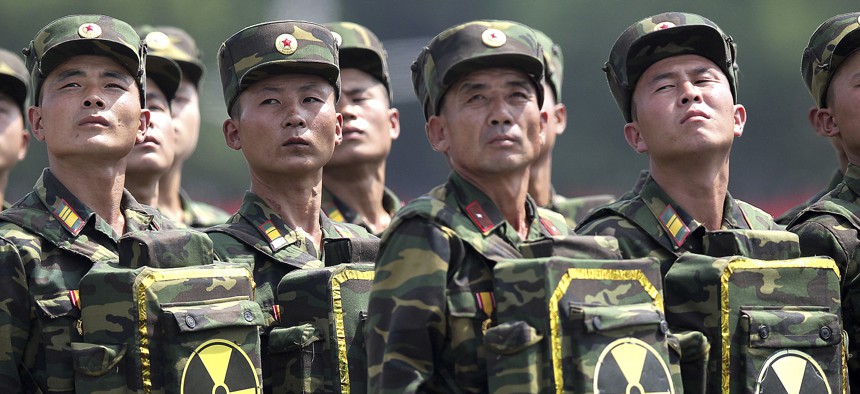
In this July 27, 2013 photo, North Korean soldiers turn and look towards their leader Kim Jong Un as they carry packs marked with the nuclear symbol during a ceremony marking the 60th anniversary of the Korean War armistice in Pyongyang, North Korea. AP Photo/Wong Maye-E
Two Ways to Read the Newest Intelligence on North Korea
Is Kim Jong Un serious about denuclearizing? Or is he out to trick the United States?
First came reports last month that North Korea was upgrading nuclear and missile facilities and increasing production of fuel for nuclear bombs at secret sites. Then came a report this week in The Washington Post that the North is building new long-range missiles and exploring ways to hide the extent of its nuclear-weapons program from the United States.
What does all this add up to? Is Kim Jong Un serious about his commitment at the June Singapore summit to “work toward complete denuclearization of the Korean peninsula”? Is he instead out to trick the United States into making concessions for little in return? Or are the reports, which are based on U.S. intelligence assessments and commercial satellite imagery, proof of nothing much beyond standard operating procedure for a country engaged in early negotiations on an arms-control agreement?
The truth is that the same evidence can lead to opposite conclusions depending on who is evaluating it. This is often true of intelligence, which tends to come in scraps that require a considerable amount of analysis and inference to tell any particular story—a story, moreover, that can change dramatically with even small variations in starting assumptions. Yet it’s perhaps especially true in the case of intelligence related to North Korea’s nuclear program, since the intentions and activities of the nation’s leaders are uniquely opaque, and talks with the United States are at such a preliminary stage. The Singapore summit has left a trail of tea leaves, and there are multiple ways to read them.
The fresh evidence of missile work, for example, comes primarily from imagery gathered by the U.S. National Geospatial-Intelligence Agency that “points to ongoing work on at least one Hwasong-15” intercontinental ballistic missile (ICBM) at a missile factory, according to The Washington Post, which cited anonymous officials “familiar with the intelligence.” But Reuters soon followed up with a suggestion that the signs of such moves might be largely circumstantial. “Photos and infrared imaging indicate vehicles moving in and out of the facility … but do not show how advanced any missile construction might be,” Reuters noted, citing an unnamed “senior U.S. official.” It added that while “one photo showed a truck and covered trailer similar to those the North has used to move its ICBMs,” the cover on the trailer meant “it was not possible to know what, if anything, it was carrying.”
Related: North Korea Talks Have Entered the Realm of Small Victories
Related: The One Word Missing From Kim Jong Un’s ‘Very Nice Note’ to Trump
Related: America and North Korea Are Having Two Different Conversations
The arms-control expert Jeffrey Lewis, who was quoted in the Post’s article stating that “North Korea is not negotiating to give up their nuclear weapons,” noted in a later podcast that his research team had also tracked through satellite imagery ongoing activity at the factory that was consistent with missile construction. But he also acknowledged that they couldn’t confirm from those open-source images alone that new ICBMs were in fact being built, even if that was the most plausible explanation. A red trailer visible in one photograph might have been used to transport part of a Hwasong-15, he observed. Or “it might just be a fucking shipping container.”
The case for pessimism in response to these reports goes something like this. It’s true that North Korea’s reported activities are “not per se a violation of the Singapore agreement because we really don’t have an agreement,” said Bruce Klingner, a former top Korea analyst at the Central Intelligence Agency now at the Heritage Foundation. What came out of the Trump-Kim summit was a “bare-bones … communique” in which the North Korean leader committed to a vague objective of “denuclearization” but not to halt his nuclear and missile production and development, let alone reverse or eliminate it.
Nevertheless, these activities are a “violation of the spirit” of the Singapore statement and also do not “seem to be consistent with a government that’s about to abandon all these programs and production facilities.” Why continue to invest in expanding a nuclear program you’d have to dismantle as part of a nuclear deal? The activities do, however, appear to be consistent with Kim Jong Un’s statement in January about North Korea pivoting from testing missiles and nuclear weapons to mass-producing them.
Of North Korea’s unverified destruction of a nuclear-test site and partial dismantlement of a satellite-launch site in recent weeks, Klingner said “perhaps we will look back and say those really were the first of many steps that led us to be convinced” that North Korea was willing to give up its nuclear weapons. At this point, however, they seem, as with North Korea’s recent return of some alleged remains of American soldiers killed during the Korean War, to be “welcome developments but not indicative of denuclearization.”
“History is a very good predictor for the future,” Klingner told me, noting the many unsuccessful efforts over the past 25 years to end North Korea’s nuclear pursuits. “But it’s not perfect. So perhaps this time is different,” even though “so far it doesn’t seem to be,” and diplomacy should proceed.
For this time to really be different, however, North Korea needs to provide the United States with a much more thorough accounting of the various elements of its nuclear program, agree to much more detailed language on denuclearization, and consent to much more robust procedures to independently verify that denuclearization than it has in the past, Klingner said.
“When the Soviets gave us a data declaration [on their nuclear-weapons program] and it wasn’t the exact same numbers as the [U.S. intelligence] community numbers, we instantly assumed they were hiding stuff,” he noted. “And it turned out over time, when we did inspections, we refined our own numbers and they came closer to the Soviet numbers.”
“You test their intentions,” Klingner continued. “You make sure you close all the loopholes. You painfully detail what is a missile, what is a nuclear weapon, what does it mean for it to be destroyed, what kind of inspections are allowed, how many are allowed, what equipment is the inspection team allowed to bring with it.”
“You’re buying a car from someone who’s cheated you on eight previous agreements. You are going to define what a car is. It can’t be a toy car. It has to have an engine. It has to have a carburetor. You’re going to get your lawyer involved to make sure there is no way they can cheat you a ninth time.”
There are plenty of reasons to think North Korea will not completely relinquish its nuclear arsenal, from its long record of breaking or not fully implementing previous accords to its long string of pronouncements about its nuclear deterrent being a “treasured sword” against American aggression. But even if the United States finds itself staring down a “rabbit hole” it’s worth going“down it a little bit further,” Klingner advised. The challenge for the Trump administration is figuring out, in the absence of some blatantly bad-faith behavior like another North Korean nuclear test, when it has gone too far down the hole and needs to shift back to its “maximum pressure” approach or some other strategy for containing the North Korean nuclear threat. “If you’re three months down the road, six months down the road, and you still are at where we are today with no seeming progress, what day do you pull the plug?” he asked.
When I reached the Korea expert Joel Wit, however, he had a markedly more optimistic reaction to the same developments. After reading aloud the first lines of the Post’s report, he abruptly stopped. “Yeah?” he asked, as if pressing me to tell him what the big news was in the latest news. “OK??”
The Singapore statement, despite Donald Trump’s exaggerated claims about its import, “was just a declaration of what the two sides intended to achieve,” Wit explained. “Now they need to sit down and actually achieve that. … In the meantime I would not expect the North Koreans to stop work on the [nuclear] program.”
“If you look at the history of every nuclear arms-control negotiation [from] the end of the Cold War up until the present day, you will find that as people are negotiating, the countries participating … are still building weapons until the agreements are finalized”—both because they’re hedging against the talks failing and because this can strengthen their negotiating position, Wit told me, citing his experience with the Russians as a State Department official in the Ronald Reagan and George H.W. Bush administrations, France’s nuclear testsin the run-up to signing the Comprehensive Nuclear-Test-Ban Treaty, and Iran’s continued work on centrifuges for producing nuclear material ahead of entering into its nuclear deal with the United States and other world powers.
Wit dismissed the notion that the North Koreans might suspend their nuclear activities as a demonstration of good faith even if they aren’t obligated to do so. (While Kim didn’t publicly pledge in Singapore to quit building missiles or churning out fissile material, he so far has honored promises made before the summit to stop tests of nuclear bombs and intercontinental ballistic missiles.)
“Why should they?” Wit asked. “Seven or eight months ago, we all thought we were on the brink of a nuclear war with these people. And then all of a sudden they’re going to show us ... good faith by stopping their main defensive program? ... That’s ridiculous. No government’s going to do that—and certainly no government you’ve had hostile relations with for” decades.
He added that while “everyone dismisses” the unilateral steps that North Korea has taken since Singapore—such as the demolition work it has begun at a satellite-launch site that has played an important role in the country’s missile program—these are efforts by the North Koreans to show “sincerity.” And the trust-building measures that both North Korea and the United States have implemented so far are understandably limited, because the reservoir of trust between the two sides is so limited. What could come next, he predicted, is an interim agreement in which, for instance, the two Koreas and the United States formally declare an end to the Korean War in exchange for the North disclosing details of its production of missiles and nuclear material, agreeing to a plan for U.S. authorities to help verify its progress on denuclearization, and turning its Yongbyon nuclear facility into a peaceful scientific and industrial site.
What about The Washington Post’s reporting that North Korea might try to conceal the true number of nuclear warheads it has, claiming to have only 20 when U.S. analysts suspect it has dozens more? Wit didn't seem rattled by this either. “They can say what they want,” he told me. “The point of any agreement is to verify their declaration.”
What united the perspectives of Wit and Klingner was a sense that the latest intelligence assessments revealed a North Korea mostly persisting with business as usual in the absence of a firm nuclear agreement—and that what’s needed next is for the United States to probe whether such an agreement is possible. Where the interpretations diverged is in how much stock the two men seemed to place in the prospect of a real deal materializing and actually curbing the usual business.




